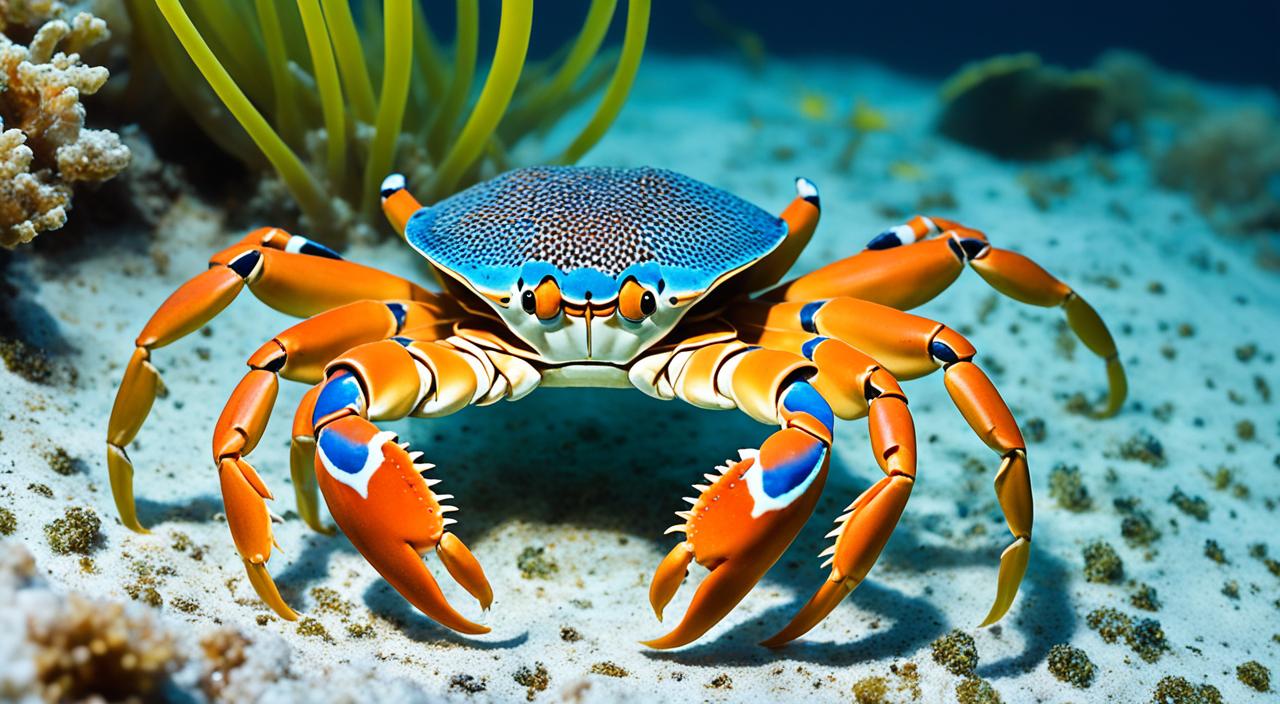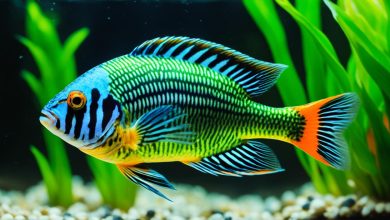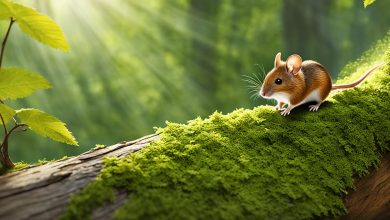Chionoecetes Bairdi, also known as the Tanner crab, lives in the North Pacific Ocean. It ranges from Alaska to Oregon. This crab is key to Alaska’s seafood economy through commercial fishing.
We’ll explore the Tanner crab’s world. We’ll look at its biology, where it lives, its life cycle, and why it matters in the region.
The Tanner crab belongs to the Chionoecetes genus. This group includes snow crabs in the Bering Sea and North Pacific. It’s the only Chionoecetes species in the Kodiak Archipelago’s waters.
From 1967 to 1994, the Tanner crab fishery was big for the area’s economy. In 1978, the crab population hit over 32 million pounds.
Introduction to Chionoecetes Bairdi
Latin Name and Classification
Chionoecetes Bairdi, also known as the Tanner crab, is a type of crustacean. It belongs to the family Majidae, or spider crabs. This species is part of the Chionoecetes genus, which includes other Tanner crabs in the northern Pacific Ocean.
Physical Characteristics and Identification
The Tanner crab has a round, flat shell with two big “horns” on the front. It has four pairs of thin, sharp legs that make it look like a spider. Its shell is usually brown and has a rough texture.
It is related to other important crustaceans like the Snow Crab and the Queen Crab. Being able to tell these species apart is key for managing fisheries and doing research.
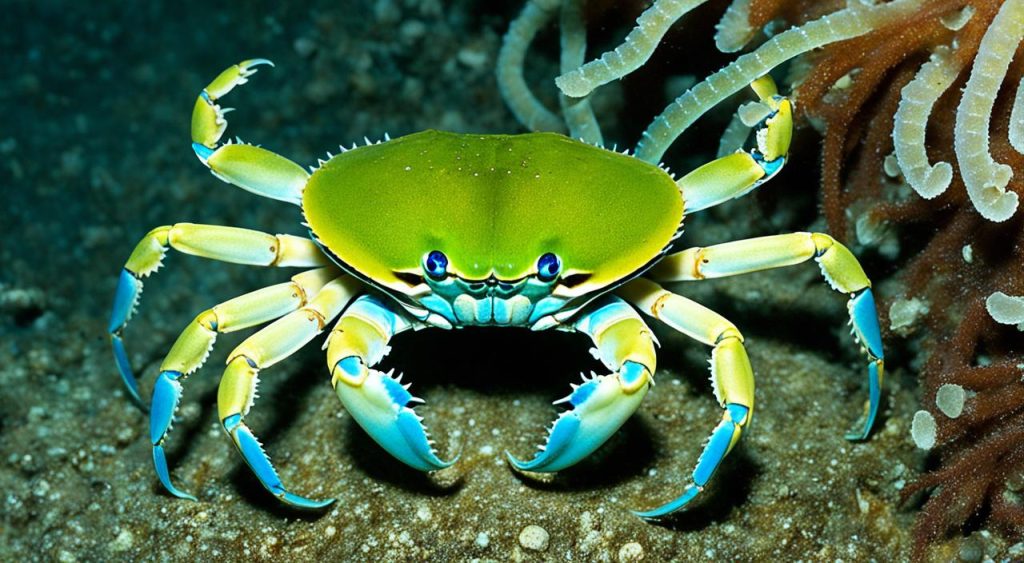
The Tanner crab’s looks and its place in the family tree help us understand its role in the ocean. This knowledge is vital for studying its behavior and its role in the marine world.
Habitat and Distribution
The Tanner crab, known as Chionoecetes bairdi, lives in the eastern Pacific Ocean. It’s found from Alaska to Oregon. They like shallow to deep waters, up to 400 meters deep. Their home is on the seafloor, where it’s muddy or sandy.
In British Columbia, Canada, Chionoecetes bairdi is common in coastal areas and offshore. But it’s not as common as in Alaskan waters, where it’s a big part of the fishery. Chionoecetes tanneri and Chionoecetes angulatus live in deeper waters, from 500 to 3,000 meters, along the coast from California to Japan.
The Department of Fisheries and Oceans (DFO) in British Columbia has studied these crabs. They found that Chionoecetes tanneri lives between 458 and 1,784 meters deep. Adult males stay between 580 and 670 meters deep. Females live deeper, between 670 and 720 meters.
| Species | Depth Range | Habitat | Distribution |
|---|---|---|---|
| Chionoecetes bairdi | 0 to 400 meters | Muddy or sandy seafloor | Eastern Pacific Ocean, Alaska to Oregon |
| Chionoecetes tanneri | 500 to 3,000 meters | Continental slope | California to Japan |
| Chionoecetes angulatus | 500 to 3,000 meters | Continental slope | California to Japan |
Knowing where these Tanner crabs live is key to managing and protecting them. It helps with sustainable fishing in the Pacific Ocean.
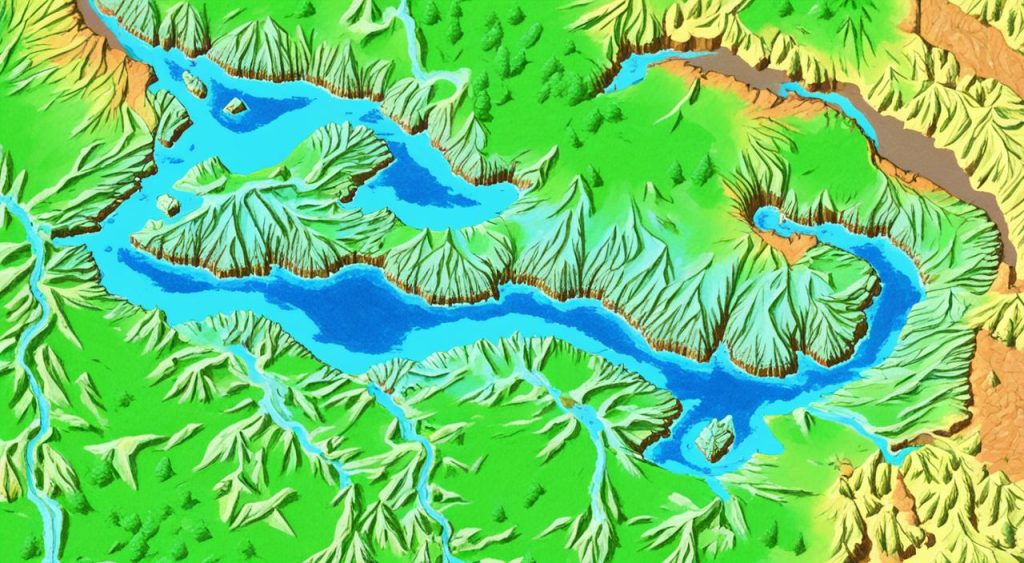
Life Cycle and Reproduction
The Chionoecetes bairdi, or Tanner crab, has a complex life cycle with many stages. It starts with the hatching of larvae. These larvae go through several stages, including zoea and megalopa, for about two months before settling on the seafloor.
Larval Stages and Development
The Chionoecetes bairdi larvae are key to the species’ survival and growth. They go through zoea and megalopa stages before becoming juvenile crabs. This takes about two months, depending on the environment’s conditions.
Growth and Maturity
As Chionoecetes bairdi juveniles grow, they molt often. The time between molts gets longer as they get bigger. Females become sexually mature after their 13th molt, usually at 5 years old. Males mature later, after about 18 molts, at 6 years old.
Tanner crabs keep molting throughout their lives. Males can live up to 12 years and females up to 9 years.
| Characteristic | Female | Male |
|---|---|---|
| Age at Sexual Maturity | 5 years | 6 years |
| Number of Molts to Maturity | 13 | 18 |
| Maximum Lifespan | 9 years | 12 years |
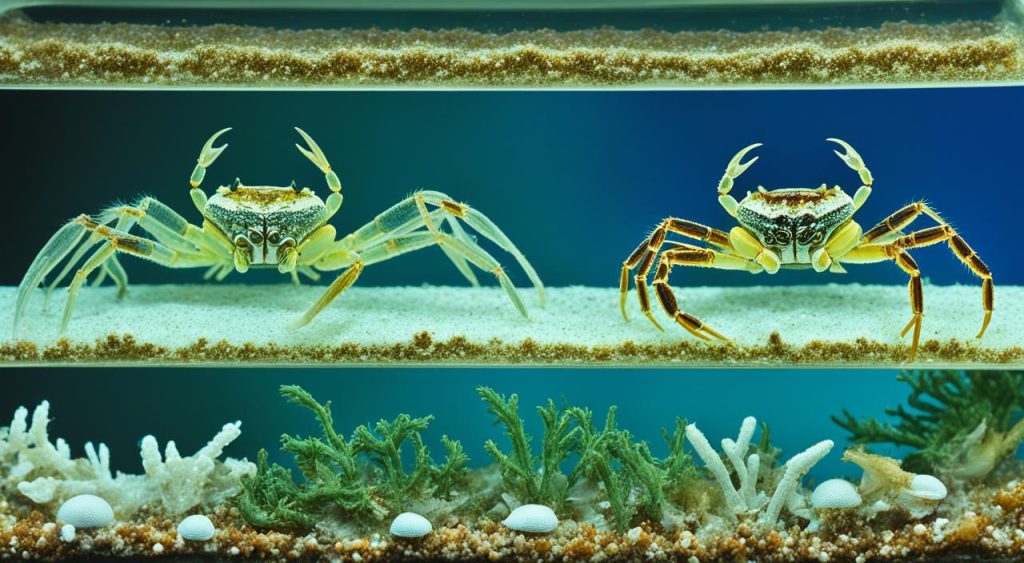
“The Tanner crab’s complex life cycle, with its distinct larval stages and intricate molting process, is a testament to the species’ resilience and adaptation to the challenging marine environment.”
Chionoecetes Bairdi
Importance in Alaska Fisheries
The Tanner crab, known as Chionoecetes bairdi, is key in Alaska’s fishing industry. It started in the late 1960s and grew big in the Kodiak area by the 1970s. These crabs are caught when they are 7 to 11 years old and weigh 2 to 4 pounds.
Female Tanner crabs lay 85,000 to 424,000 eggs at a time. They can live up to 14 years. Males grow to 1 to 4 pounds and reach maturity in about 7 years.
Regulatory History and Management
But, the Tanner crab numbers went down, leading to more rules like catch limits and season closures. The fishery closed in 1994. Since then, it’s been managed with research and quotas to avoid overfishing.
The Crab Rationalization Program started in the mid-2000s. It gives fishing quotas to boats based on their past catches. This helps prevent overfishing but can be hard for small-scale fishers who feel it limits their opportunities.
The Tanner crab fishery shows how important good management is. It balances commercial needs with protecting the resource. With ongoing research and rules, Alaska’s crab industry can grow sustainably.
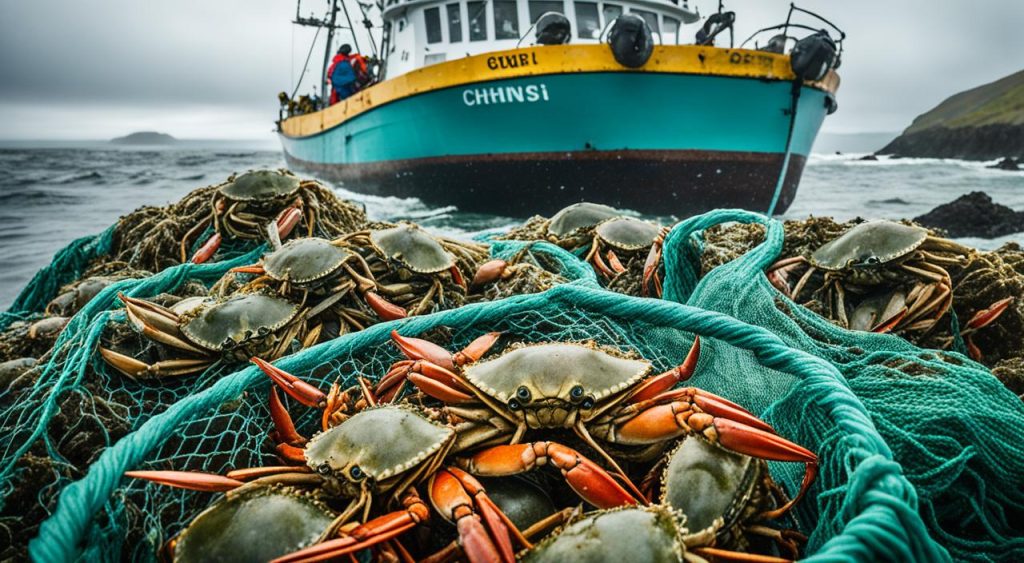
“The Crab Rationalization Program has helped manage the Tanner crab fishery, but small-scale fishers have concerns about being limited to their allotted share.”
Ecological Role and Predators
The Chionoecetes bairdi, also known as the Tanner crab, is key to the ocean’s balance. As larvae, they feed many marine animals, like zooplankton, fish, and whales. Once they settle, they become food for predators such as Pacific cod, Pacific halibut, octopus, and sea otters.
Predation by Marine Species
Many marine animals rely on Tanner crabs for food. Their larvae are eaten by:
- Zooplankton
- Fish
- Baleen whales
Once Tanner crabs grow and live on the seafloor, they face predators like:
- Pacific cod
- Pacific halibut
- Octopus
- Sea otters
Human Impact and Fishing Pressure
Humans also prey on Tanner crabs, mainly through commercial fishing. Overfishing and fishing pressure have hurt Tanner crab populations in some places. The Alaska Tanner crab fishery started in 1961 and has seen big harvests and closures due to low numbers.
| Metric | Value |
|---|---|
| Record domestic Tanner crab harvest | 123 million pounds in 1978 |
| Record domestic snow crab (C. opilio) harvest | 332 million pounds in 1991 |
| Tanner crab fishery closures | 1986, 1987, 1996, 1997 |
| Crab Rationalization Program implementation | Mid-2000s |
The Alaska Board of Fisheries (BOF) and the Alaska Department of Fish and Game (ADF&G) manage Alaska’s fisheries. They aim for a sustainable yield for everyone’s benefit. The Division of Commercial Fishery in Alaska and the ADF&G have done many studies on Tanner crabs.
Commercial Fishing and Harvesting
Fishing Methods and Gear
The chionoecetes bairdi, also known as the Tanner crab, is crucial in Alaska’s crab fishing. Tanner crab harvesting uses various methods and gear, like pots, traps, and trawls.
Pot and trap fishing are the main crab fishing methods. Fishermen use baited traps to catch crabs on the seafloor. Trawling, dragging a large net, also targets Tanner crabs but can harm the marine environment.
The crab fishing gear includes pots and trawl nets. Fishermen follow strict rules to manage Tanner crab populations sustainably.
The Tanner crab harvest in Alaska has seen big changes. Last year, Kodiak had 1.1 million pounds available for harvest. This year, the quota is over 5 million pounds, the biggest in two decades. With 104 vessels ready, the season is expected to move fast.
Parasites and Diseases
Chionoecetes bairdi, also known as the Tanner crab, faces many parasitic infections and diseases. These can greatly affect its health and numbers. Black mat syndrome and bitter crab disease are two main infections it deals with.
These infections can mess up the crab’s molting and may cause death. They spread through poor waste disposal and crab-on-crab eating.
Studies show over 40 crustacean species in the Pacific and North Atlantic have Hematodinium spp. infections. This parasite has two types, each preferring different hosts.
| Parasite/Disease | Impact on Tanner Crabs | Prevalence |
|---|---|---|
| Black Mat Syndrome (Fungus) | Disrupts molting process, leading to death | Disease prevalence in Tanner crabs in 1985-1986: 100% |
| Bitter Crab Disease (Dinoflagellate Parasite) | Prevents proper molting, ultimately causing mortality | Parasite prevalence in Tanner crabs: 95% |
These parasites have a big effect on the Tanner crab fishery. In the mid-1980s, the catch was about 1.2 million pounds, worth $2.3 million. But, the loss from “bitter” crabs was over $175,758 for two companies in 1986.
Research and monitoring are key to understanding and managing these infections. This helps keep the Tanner crab fishery sustainable.
Conservation and Management Efforts
Due to the decline of Tanner crab populations, conservation efforts have started. These efforts aim to protect and sustain this species. They focus on making sure the Tanner crab fishery lasts long and is managed sustainably.
Sustainable Practices
One key measure is stricter rules, like catch limits and seasonal closures. These rules help reduce the impact of fishing on Tanner crab populations. They also help recover depleted stocks.
Research and Monitoring Programs
Research and monitoring programs are also crucial. They collect data on Tanner crab numbers, size, and age. They also look at environmental factors that affect their survival and reproduction.
This data helps guide management decisions. It ensures the Tanner crab fishery is managed sustainably. Catch limits and gear restrictions are adjusted as needed to protect the species.
| Conservation Measure | Description |
|---|---|
| Catch Limits | Restrictions on the total amount of Tanner crabs that can be harvested in a given season or area. |
| Pot Limits | Limits on the number of crab pots that can be used by individual fishermen or vessels. |
| Seasonal Closures | Temporary closures of the Tanner crab fishery during critical life stages or spawning periods. |
| Research and Monitoring | Scientific studies and data collection to assess the health and status of Tanner crab populations. |
By combining sustainable fishing and research, the management of Tanner crab aims for long-term conservation. This ensures the survival of Chionoecetes bairdi populations. It also keeps this important resource available for the future.
Exploring New Fisheries for Tanner Crabs
The Chionoecetes bairdi, or Tanner crab, is key in Alaska’s seafood. Yet, other Tanner crab species are being looked at for new fisheries. Chionoecetes tanneri and Chionoecetes angulatus, two deep-water tanner crab species, are being studied in British Columbia, Canada. They live in deeper waters than the Chionoecetes bairdi and could be good for commercial exploitation.
Looking into new Tanner crab fisheries could make the seafood industry more varied. Surveys have been done to learn about these deep-water Tanner crabs. The goal is to see if it’s possible to start a tanner crab fishery in the area.
The Wuikinuxv (Oweekeno) First Nation in British Columbia wants to start a fishery for the chionoecetes bairdi, or inshore Tanner crab, in Rivers Inlet. This could lead to a new crab fishery diversification in the region.
FAQ
What is the scientific name and classification of the Tanner crab?
The Tanner crab is scientifically known as Chionoecetes Bairdi. It belongs to the family Majidae, or spider crabs. This crab is classified under the genus Chionoecetes, which includes several species found in the northern Pacific Ocean.
What are the physical characteristics of the Tanner crab?
Chionoecetes Bairdi has a round, flattened shell with two “horns” on the front. It also has four pairs of slender, pointed legs. The crab’s shell is typically brown and has a rough, bumpy surface.
Where is the Tanner crab found?
You can find Chionoecetes Bairdi in the eastern Pacific Ocean. It ranges from Alaska to Oregon and also near Japan in the western Pacific. They live in shallow to deep waters, preferring muddy or sandy bottoms.
What is the life cycle of the Tanner crab?
The Tanner crab’s life starts with larvae that go through several stages before settling on the seafloor. Young crabs molt often, with longer periods between molts as they grow. Females become sexually mature after 13 molts, at about 5 years old. Males mature after up to 18 molts, at around 6 years old.
What is the commercial significance of the Tanner crab?
In Alaska, Chionoecetes Bairdi is a key species for the crab fishery. The fishery started in the late 1960s. Now, it has rules like catch limits and season closures to keep it sustainable.
What is the ecological role of the Tanner crab?
Tanner crabs are crucial in the ocean ecosystem. As larvae, they are eaten by many marine animals. Once on the seafloor, they are preyed upon by species like Pacific cod and sea otters.
What are the common fishing methods used to harvest Tanner crabs?
Fishing for Tanner crabs uses pots, traps, and trawls. Pots and traps are the main methods, with baited traps catching crabs on the seafloor. Trawling, dragging a large net, also targets Tanner crabs but can harm the environment and catch other animals.
What are some of the parasites and diseases that affect Tanner crabs?
Tanner crabs face black mat syndrome and bitter crab disease. Black mat is a fungus, and bitter crab disease is from a dinoflagellate. These infections can stop the crab from molting and may kill it. These diseases spread through discarded crabs and crab-on-crab behavior.
What conservation and management efforts are in place for Tanner crab populations?
Conservation efforts are needed because Tanner crab numbers are down in some areas, like the Kodiak Archipelago. Rules like catch limits and seasonal closures help protect them. Research and monitoring programs also track the health of Tanner crab populations.
Are there any new Tanner crab fisheries being explored?
Yes, new Tanner crab species are being researched and fished in deep waters off British Columbia, Canada. These species, Chionoecetes tanneri and Chionoecetes angulatus, live in deeper waters and might be good for commercial fishing.
